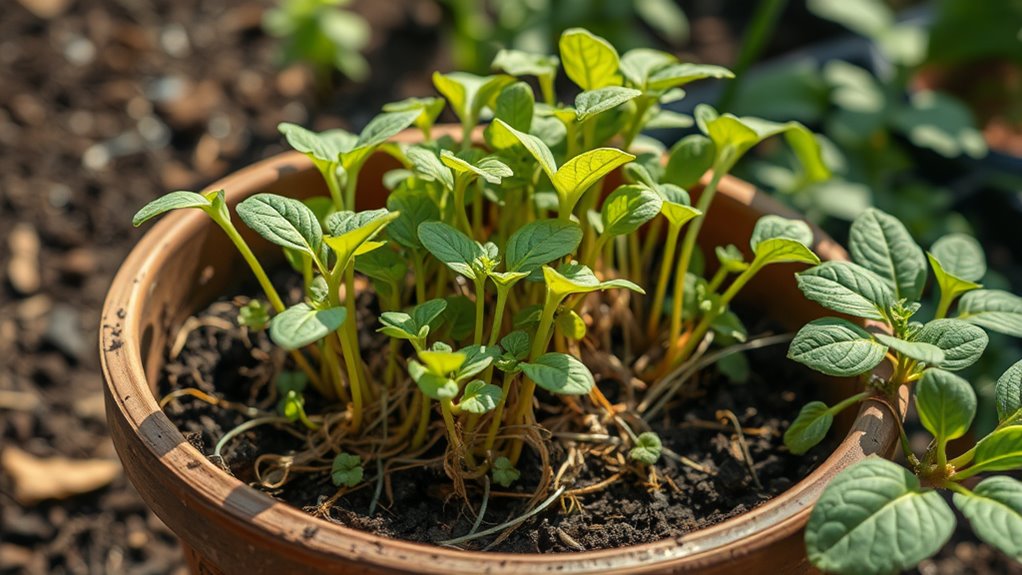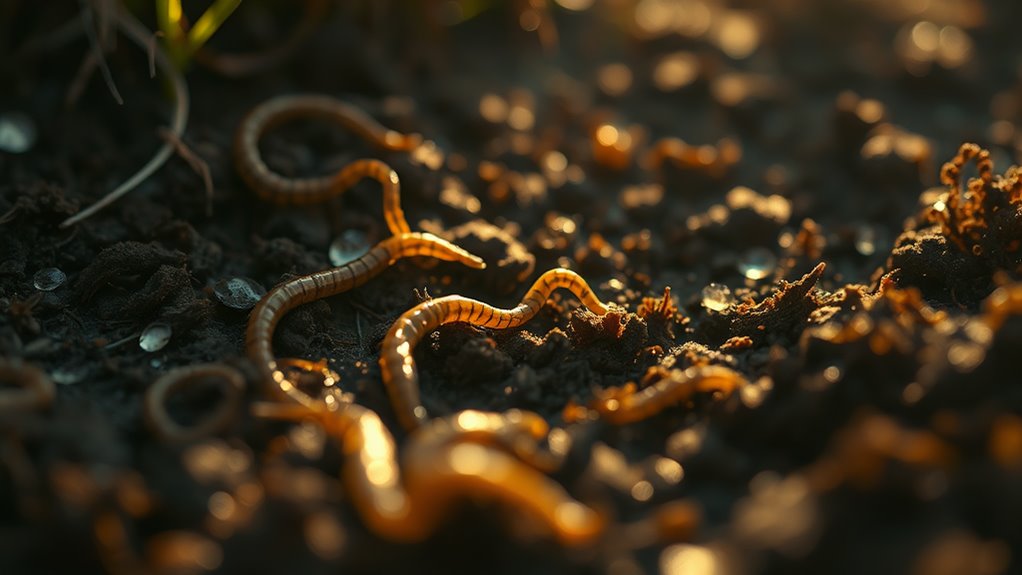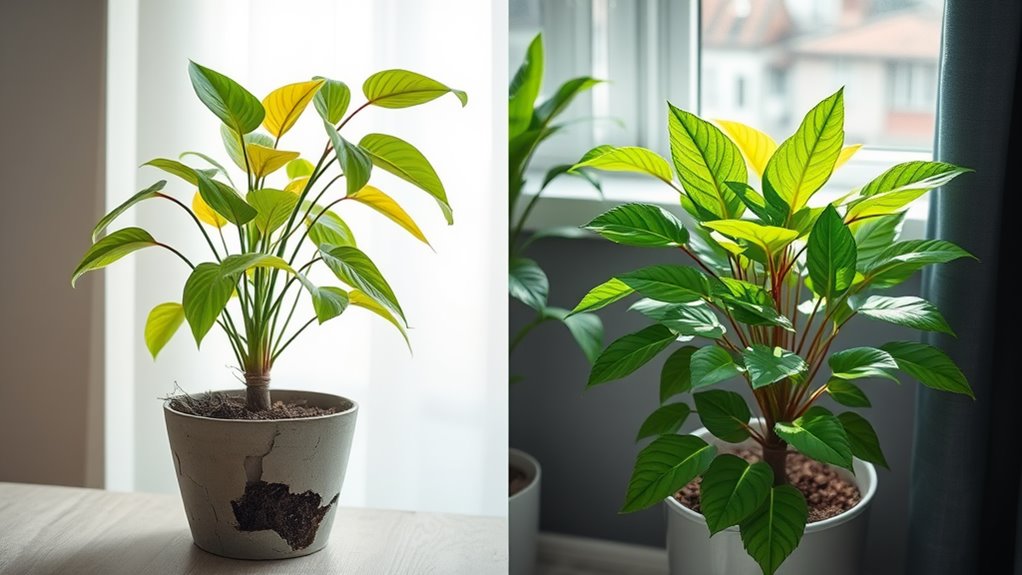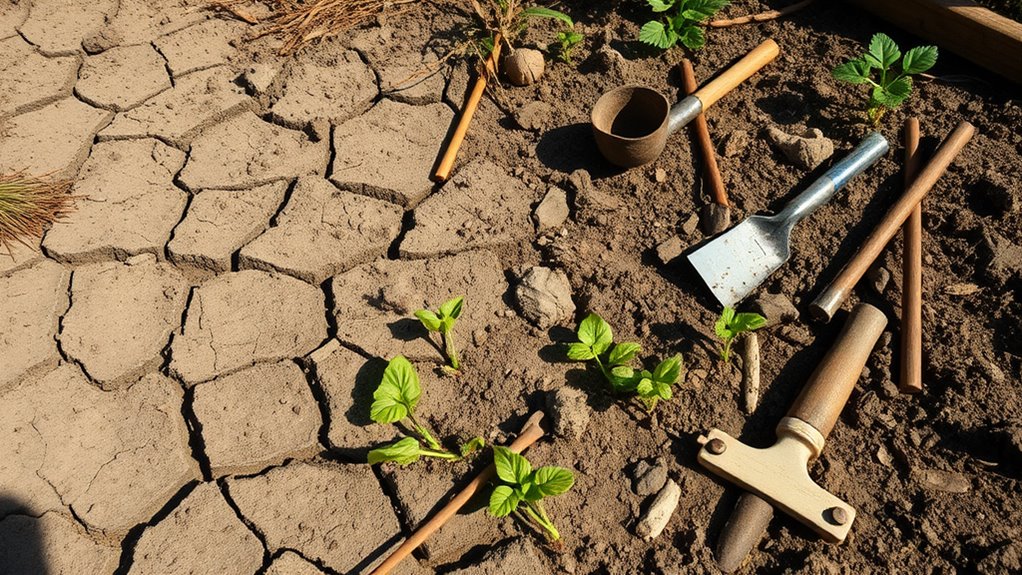The Biggest Beginner Gardening Mistake You Probably Didn’t Know
You might not realize that overwatering your plants is the biggest beginner gardening mistake—it’s easy to do without knowing. This suffocates roots, causing hidden issues like root rot, yellowing leaves, and stunted growth, even when soil feels damp. Check moisture with your finger an inch deep before watering, and ensure proper drainage for healthier plants. Exploring these pitfalls further will help you cultivate a more robust garden.
Key Takeaways
- Overwatering plants suffocates roots, causing rot and stunted growth even in moist soil.
- Ignoring sunlight needs leads to weak plants by placing sun-lovers in shady spots.
- Planting at the wrong time results in poor germination due to mismatched seasonal cycles.
- Overcrowding gardens forces plants to compete for resources, reducing yields and health.
- Selecting incompatible plants causes competition for water and nutrients, inviting disease.
Overwatering Your Plants
When you overwater your plants, you’re essentially suffocating their roots by displacing essential oxygen in the soil. This common gardening newbie mistake leads to root rot, yellowing leaves, and stunted growth, as excess water creates a breeding ground for harmful fungi.
You’ll notice wilting even when soil feels wet, signaling poor drainage or overzealous watering habits. To avoid this, check soil moisture before watering—stick your finger in an inch deep; if it’s damp, wait.
Gardening newbie mistakes like this can kill plants quickly, so use a watering can with a fine rose for even application and monitor weather conditions closely. In case of overwatering, implement recovery techniques to restore your plant’s health.
To foster thriving plants, it’s essential to follow practical tips for achieving the right watering balance.
Neglecting Soil Preparation
You often neglect soil preparation, which leaves your garden vulnerable to nutrient deficiencies and poor drainage.
Start by mastering soil testing essentials to accurately assess your soil’s pH and nutrient levels.
Then, address nutrient deficiency risks and implement drainage improvement tips to create a healthy foundation for your plants.
Additionally, soil testing can increase crop yields by optimizing nutrient availability and promoting robust plant development.
Moreover, by following practical steps for conducting the test and interpreting the results, you can effectively identify and remedy potential garden issues.
Soil Testing Essentials
One common beginner error in gardening is neglecting soil testing, which sets the stage for poor plant health and yields.
As a gardener, you should start by collecting soil samples from various depths and locations in your garden for a representative analysis. Use an affordable pH test kit to measure acidity or alkalinity, as this influences root growth and water retention.
Don’t forget to assess soil texture by feeling it—sandy soils drain quickly, while clay holds water too long. For accurate results, send samples to a local lab.
Based on findings, adjust your soil’s structure with amendments like compost, ensuring it’s primed for planting. This practical step saves time and resources.
Nutrient Deficiency Risks
Failing to prepare soil after testing opens the door to nutrient deficiencies that stunt plant growth.
You might face nitrogen shortages, causing yellowing leaves and reduced vigor, or phosphorus lacks that hinder root development and flowering.
Potassium deficiencies weaken stems, making plants more prone to pests and diseases, ultimately lowering yields.
To address this, amend your soil with targeted fertilizers or compost based on test results.
Regularly check and adjust pH levels—aim for 6.0 to 7.0—to enhance nutrient absorption.
This proactive approach ensures robust plants and maximizes your garden’s potential.
Drainage Improvement Tips
Neglecting soil drainage during preparation can lead to waterlogged roots and stunted growth, so you’ll want to assess and amend your soil early. Start by testing soil percolation; if it drains slowly, mix in coarse materials like perlite or gravel. Grade your beds to slope away from plants and use raised beds for poor soils. Here’s a quick guide to common issues and fixes:
| Soil Issue | Improvement Tip | Expected Outcome |
|---|---|---|
| Clay-heavy soil | Add 50% sand or perlite | Faster water drainage |
| Compacted ground | Aerate with a fork | Increased air circulation |
| Poorly graded | Create 2-4% slope | Prevents water pooling |
| Waterlogged spots | Install French drains | Redirects excess water |
| Root-bound areas | Amend with organic matter | Loosens soil structure |
Implementing these steps ensures healthier roots and vibrant growth.
Ignoring Sunlight Requirements
Why do so many beginner gardeners overlook their plants’ sunlight needs, leading to stunted growth or failure?
Every plant has specific requirements—full sun (6-8 hours daily), partial shade, or full shade—to drive photosynthesis and health. You risk weak stems, pale leaves, or poor flowering when you plant sun-loving species in shady spots or vice versa.
To address this, measure your garden’s sunlight by tracking daily exposure with a simple timer or app. Match plants to appropriate areas; for instance, roses thrive in bright light, while hostas prefer dappled shade.
This precision prevents common pitfalls and ensures vibrant results. Additionally, incorporating soil preparation techniques from essential gardening tips can further optimize your plants’ ability to utilize sunlight effectively.
Furthermore, pairing optimal sunlight with watering techniques is essential to avoid hydration-related issues and support robust plant development.
Planting at the Wrong Time
You need to identify the ideal planting times for your plants based on their specific growth cycles and your region’s seasons to avoid common pitfalls.
For instance, in culinary gardening, proper herb timing can help achieve maximum flavor in herbs.
If you delay planting beyond these optimal windows, you’ll risk poor germination, weaker plants, or total crop loss.
Always adjust your schedule according to local climate factors like frost dates and temperature variations for the best results.
Furthermore, consider companion planting to avoid planting vegetables that negatively affect each other’s growth.
Ideal Planting Times
One of the most common beginner mistakes is planting at the wrong time, which can stunt growth or kill young plants. To avoid this, you must consider your local climate and plant hardiness zones, as determined by the USDA.
Check the average last frost date in your area using reliable resources like extension services or online calculators. For cool-season crops, plant in early spring; warm-season ones like tomatoes thrive after the last frost.
Always match seed packets’ instructions to your zone for optimal results. Test soil temperature with a thermometer to ensure it’s suitable—aim for 50-70°F depending on the plant. This precision helps you establish healthy gardens effortlessly.
Consequences of Delay
Delaying planting past the ideal window often stunts plant growth, as seedlings face harsher weather or pest pressures that weaken their establishment.
You’ll notice weakened root systems, making plants more susceptible to drought or disease, which reduces overall yields.
Active infestations can overwhelm young shoots, leading to stunted maturation and poor fruit set.
In extreme cases, you risk total crop failure, as delayed starts mean plants compete poorly for resources.
This mistake forces you to deal with prolonged vulnerability, ultimately diminishing your garden’s productivity and satisfaction.
Stay vigilant to avoid these pitfalls.
Adjust for Climate
Failing to adjust for your local climate when planting can undermine even the best-laid garden plans. You must determine your USDA hardiness zone and key frost dates to align planting with seasonal conditions.
For instance, sowing warm-season crops like tomatoes before the last spring frost risks damage from cold snaps, halting growth or killing seedlings. Cool-season vegetables, such as spinach, thrive in cooler weather, so time them for early spring or fall.
Use reliable tools like weather apps or extension services to monitor patterns and adjust schedules. This practical approach maximizes yields, avoids failures, and ensures resilient gardens.
Overcrowding Your Garden
Overcrowding your garden forces plants to compete fiercely for sunlight, water, and nutrients, which stunts their growth and invites pests and diseases.
As a result, you’ll notice weaker stems, reduced yields, and tangled roots that limit airflow and water absorption. Additionally, this issue often leads to beginner gardening pitfalls that undermine the overall health of your plants.
To avoid this, always consult seed packets for specific spacing guidelines—leafy greens need 6-12 inches, while larger plants like tomatoes require 18-24 inches.
Plan your layout on paper first, measuring accurately during planting to ensure proper distances.
Regularly thin seedlings early, promoting healthier root development and preventing stress that hampers overall productivity in your garden.
By addressing overcrowding, you’ll be mitigating one of the common gardening mistakes that lead to suboptimal plant performance.
Forgetting Pest Control Basics
While pests are an inevitable part of gardening, forgetting basic control measures can turn your thriving plants into a feast for invaders.
You need to stay proactive to safeguard your garden and ensure healthy growth.
Embracing natural pest control strategies can further protect your plants while supporting an eco-friendly garden environment.
To enhance your pest management, consider learning about the top five pests that commonly threaten plants, as outlined in expert resources.
-
Inspect regularly: Check leaves and stems weekly for pests like aphids or caterpillars, acting quickly to prevent outbreaks.
-
Promote natural defenses: Introduce beneficial insects, such as ladybugs, to naturally control common pests without chemicals.
-
Apply barriers: Use netting or row covers to physically block insects from accessing vulnerable plants.
-
Maintain hygiene: Remove dead plant material and weeds promptly to eliminate pest hiding spots and breeding grounds.
Selecting Incompatible Plants
Just as you’ve guarded against pests, you must carefully choose plants that thrive together to avoid garden setbacks. When you select incompatible ones, like pairing thirsty tomatoes with drought-tolerant cacti, you’re inviting stunted growth or disease. Factors like soil pH, sunlight, and water requirements matter—mismatched needs lead to competition and failure.
| Plant Type | Common Incompatibility | Practical Solution |
|---|---|---|
| Sun-loving roses | Shade-preferring ferns | Plant in separate areas |
| Acid-loving azaleas | Alkaline soil lovers | Amend soil pH accordingly |
| Fast-growing vines | Slow-maturing perennials | Use barriers or spacing |
| High-water crops | Drought-resistant succulents | Zone by irrigation needs |
| Invasive species | Delicate ornamentals | Choose non-aggressive alternatives |





